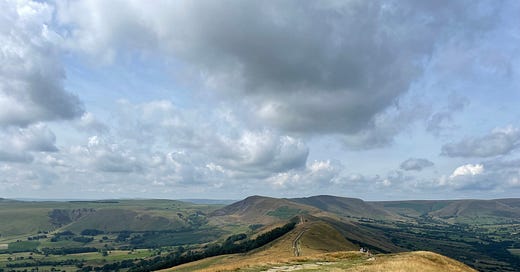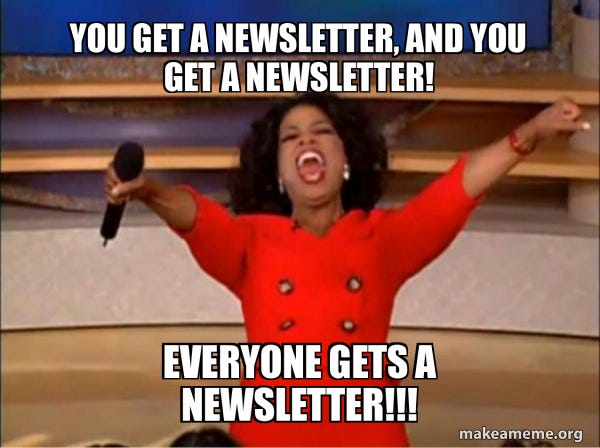A ramble: to walk for pleasure, especially in the countryside. It also can mean to talk or write in a confused way, often for a long time
Apologies in advance about the quality of the audio - I am still on the hunt for a decent microphone for my laptop!
One of the more attractive aspects about being here on Substack is that there is a different feel to it when compared to some other platforms. And by other platforms, I am referring to Instagram, Twitter, and Facebook as these are the only ones that I have experience with. Broadly speaking, things feel… positive, and less odd (and hostile) here.
To help provide some context and in advance of publishing this post, I conducted a quick non-scientific study by scrolling through Notes to gauge the mood. Here are some of my findings:
There was a range of beautiful artwork/photography being shared,
Collaboration between writers/artists,
Thoughtful quotes/restacks, and
People offering to help others
Kindness was evident.
A quick side-note, from what I can remember about Twitter, there wasn’t always a huge amount of kindness in the feed. I closed my Twitter account in 2022 due to unhealthy over-use during the pandemic, Elon Musk’s takeover, and the increasingly lax content moderation.
There is a deep well of kindness and general positivity on Substack, but equally, I still find myself wondering about several things:
Is there such a thing as Substack overwhelm?
Is it possible to reach subscription fatigue?
What makes some posts and Notes MASSIVE successes, while others are barely acknowledged? Spoiler – it’s the algorithms
So, instead of letting these questions rot at the bottom of one of my many Word documents, I decided to share them here on Substack. This platform is meant to be a beacon of free speech, right?
And just to bring this long-winded introduction to a close, this post is part a ramble through some of my thinking and part a genuine desire to organise that thinking.
I’d love to know your thoughts. Am I off the mark with any/all of this? Am I too cynical? (A question I often ask myself). Let me know in the comments. All constructive feedback is welcome, and bonus points for a ramble 😀🚶♀️➡️
1) Substack Overwhelm

Who hasn’t experienced this at some point? However, I remember feeling this acutely when I first opened my account and quite deliberately fell down the rabbit hole of how-to guides.
Whether you review the various Substack help pages or seek support from other lovely people here, you can find pretty much everything you need to get started, whether it’s about tags (I still don’t think that I am using these correctly), recommendations, About pages, logos, and so on. At times, a little digging might be required, but in comparison to setting up a Wordpress blog for instance, Substack have made it remarkably straightforward to get on with things.
Now, much of that initial overwhelm has quietened as my newsletter is up and running. Occasionally, I tinker with a few settings and may update my About page, but largely the newsletter engine runs just fine.
Yet it is Notes that continues to provide me with the most anxiety and overwhelm.
Notes has the feel of a feed akin to other social media platforms, and I do recognise its benefits. Most notably, it has helped me discover new writers and allowed me to explore and develop my hobby of photography. And within the Substack ecosystem there is an incentive to use Notes by linking to/restacking posts as it can result in work becoming more visible to others (see point 3).
But I remember finding myself nodding along to Jon Ronson (who is now here on Substack!) in his podcast ‘Things Fell Apart’ when referring to Twitter that he often felt heightened when using it. This was largely because nuance and complexity were diminished. Ronson went onto say that while he still has a Twitter account, now he primarily uses the platform for promoting his books and other work, rather than for interacting with people.
Notes is a completely different animal to Twitter (phew!), but I have noticed a similar sense of feeling heightened when I use it. When I drill down, the best that I can describe how I feel is actually pretty basic - I still seek acknowledgement and approval from others.
But on social media platforms there is a quantifiable marker for this acknowledgement and approval through likes, comments, and restacks. Yes, these markers apply for posts and for your overall newsletter (via subscribers and followers) too, but somehow it is with Notes that this hits the most.
I don’t really have any solutions to my sense of feeling heightened and overwhelm, besides going on Notes less. I could delete the app from my phone, but I also like the ease of using this. So ultimately, I am contributing to my own overwhelm!
2) Subscription fatigue
There is something deliciously refreshing about how Substack has no ads, certainly when you compare this to the chaos and noise of other platforms and websites. But I also appreciate that with no ads that a different payment model is required, thus subscriptions.
Now, I have come to accept the subscriptification of pretty much most things in life, from how we read the news, how we watch TV, for those who play computer games, and even to toilet paper. But I do wonder how Substack’s model will evolve as the platform grows and if people eventually reach subscription fatigue, both in terms of having the time to read the number of newsletters that they are subscribed to, and having the finances to subscribe in the first place.
3) The algorithms… (the biggie)
In my early months of being here, I noticed several writing about writing on Substack-type posts. These posts usually contained details about a person’s experiences on the platform, and were often accompanied with a positive take on some of the understandable challenges that can come with writing generally, and getting to know the Substack ecosystem. I also noticed that these posts had a lot of likes, comments, and restacks, which then led to an interesting domino effect, where other people shared similar posts, or thoughts on Notes.
To be clear, I am not opposed to these pieces (pot kettle black, comes to mind) nor is my intention to criticise or pass judgement on anyone, but it was interesting as a newcomer to this platform for these posts to often pop up at the top of my Notes feed.
Since then, observing what is recommended to me via Notes (Explore option) has led me to question some of the algorithms on the platform. (I mean writing about Substack on Substack is a great marketing tool for the platform and one that the company are likely to push!). I know little to nothing about computer science, but I am aware that algorithms can be the ultimate decision-makers of what gets read. And accordingly, these can be manipulated by the tech companies.
In 2022, Forbes reported that unlike with other platforms, Substack allowed writers to find a sense of freedom, where:
Not incentivized to game the algorithm, writers are pressed to do the work to discover what a reader finds interesting and engaging.
It is a great feeling when a reader finds a post interesting and engaging, and they take the time to let you know. And I am sure that more established writers feel the same way.
And it is fantastic that Substack is free at the point of entry for all, but as this platform grows, I am curious as to whether these algorithms could become gamed and incentivised to direct traffic. For example, more established writers are likely to have larger paid readerships, which helps to keep Substack’s lights on (FYI - I don’t worry about this). Therefore, it is in Substack’s interests to convert free subscribers and followers to paid ones, especially for those with larger readerships.
I am keen to learn more about how traffic is directed online as things seem to circle back to this. Algorithmic recommendations can have considerable influence on some of our choices, from the music we listen to, to the news we consume, and to what we see right here.
On a related point, Pandora Sykes’s excellent podcast ‘Doing It Right’ explored this area where she interviewed Kyle Chayka about his book Filterworld. There are a range of ideas discussed in the episode but the concept of relearning what we actually might like rang true for me - Do I like something because I genuinely like it, or do I like it because an algorithm has encouraged me to like it?
I feel like I need to take a beat after sharing this post because writing some of this made my head hurt. But it did provide me with an excellent distraction from reviewing the mountain of edits for my dissertation!
But as this post finally wraps up, I wanted to return to my original intention, which was to stress that there is an abundance of kindness here on Substack, and I really hope that this came across.
Right now, I am grateful that this platform has encouraged me to write regularly, and has allowed me to connect with some lovely people and enjoy their work.
If you made it this far here is a medal 🎖️ and see you next week with something completely different!
Take care,
Sarah






I will take that medal Sarah! Thanks for this interesting read. My two cents on this topic: I feel one should not take anything too seriously if there is any tiny bit sense of overwhelm taking a break really helps. The digital world as you rightly pointed out is about algorithms but at the end of the day if the content is good it will bring in the reader. Having said this, I also feel that the moment we put our content on a platform we have made a choice. At the end of the day all platforms have to survive in different ways. Substack’s mode of operation seems better than the other platforms. Also what may overwhelm us may be necessary for someone’s mental health. I completely agree about the kindness and support part. I do feel that this is a more generous space!! I better stop as this is becoming a mini newsletter in itself :) Cheers!
I loved this, Sarah, and didn't think it was rambling at all! And it was great hear your actual voice as well as your writerly voice 😊.
It's great, isn't it, when you've been on Substack for a bit and you've managed to let go a little of the urgency you first feel to read EVERYTHING and to take all the advice. I'm happy to be at the point where I recognise that on Substack, as in life, there's only so much I can do and so many things I can subscribe to. By choosing one thing I'm necessarily missing out on many other things, but that's OK. Just yesterday I let go of some paid subscriptions to well known names so that I can focus on "smaller" writers with whom I feel a more direct connection. I agree with you about the kindness here on Substack, and I've decided that the best way for me to show kindness is to focus my time and energy and money on a few writers, rather than trying to engage with ALL the writers 🤣. It's early days. I'll let you know how it goes 😊